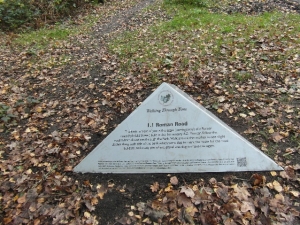The Archaeology of Sutton Park National Nature Reserve
Introduction
 People thinking of Sutton Park will conjure up images of trees, heathland, streams and pools, its wildlife and of course King Henry VIII. However, there is much more than the history of the Park. Archaeological treasures, some visible, others not easily seen, dating back to the Stone Age.
People thinking of Sutton Park will conjure up images of trees, heathland, streams and pools, its wildlife and of course King Henry VIII. However, there is much more than the history of the Park. Archaeological treasures, some visible, others not easily seen, dating back to the Stone Age.
In July 2017 the new Archaeological Interpretation Scheme (AIS) created by FoSPA, which took over two years to complete, was launched by the Rt Hon Andrew Mitchell MP for The Royal Town of Sutton Coldfield. The scheme was made possible by a generous bequest to FoSPA by Mr. Laurence William Loader, donations from Sutton Charitable Trust and Severn Trent Water. Invaluable input from Dr Mike Hodder archaeologist and author, and Roger Lea historian and author, together with the Sutton Coldfield Civic Society. It is hoped that the new panel maps and pyramid markers will help visitors understand the fascinating archaeology and history of this beautiful and diverse place Sutton Park National Nature Reserve.
AIS Stories
When you take a stroll through the woodlands, along the winding paths or sit by a pool watching the wildlife, do you ever think how they got there? Well there are lots of stories about the people and events that have taken place in the Park and surrounding area over hundreds of years. We are sure there is a great deal more that is still to be told, meanwhile we hope these pages will help you understand a little of the past and identify some of the features that normally you would be unaware of. We are grateful to Paul Crawley who provided the illustrations that help bring these stories to life.
You can read about Bronze Age settlers – 1330 BC, The Romans – 47 AD, The Deer Park – 1170 AD and recent industry in the Park – 1760 AD by clicking on the Archaeology Stories link.
AIS Walks
There are six walks you can take covering six very different areas of the Park. The walks vary in length and you will be able to see the remains of some of the items mentioned in the accompanying stories. The routes are clearly marked with pyramid markers, as above, and a panel map at the beginning of each walk.
The walks take approximately 1 to 2 hours to complete. Fospa organise guided walks led by Dr Mike Hodder in Spring and Autumn, in which he explains the historical and interesting aspects of the sites visited. You can find the dates on our Diary page.